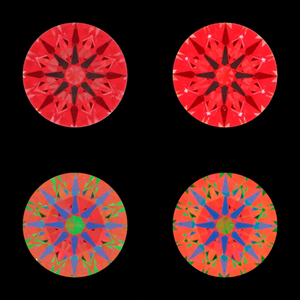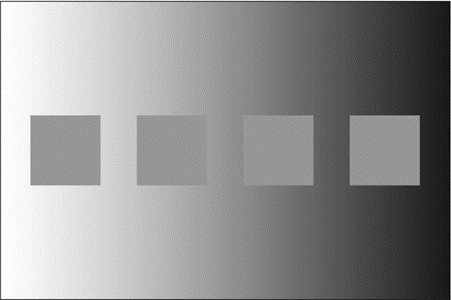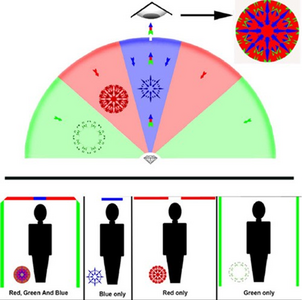- Joined
- Jul 27, 2009
- Messages
- 4,097
You Think Diamonds should have Maximum Brightness? You’re not Alone. And You’re not Right Either!
To be sure, the best diamonds are bright. But exactly what is brightness in the context of diamond light performance? Some things about brightness may surprise you!
We talk about diamonds having brilliance. Brightness is a fundamental component of diamond brilliance - but only one of the necessary components. Brightness can be thought of as the quantity of light returning to the eye. Shine a light into a mirror and 100% of the light can return to your eye – blindingly bright. But for a diamond to be brilliant there also needs to be some contrast. As the diamond or the observer moves, scintillation is triggered by the blinking of the facets. It is actually the visual dance between light and dark that gives us the sensation of brilliance. And here, the context matters even more than the absolute level of brightness. In the following graphic the gray squares are the same color. But see how their apparent brightness changes due to contrast levels of the background. The square on the right appears to be much brighter than the others.
Is maximum brightness the ‘be all and end all’ of diamond light performance? The answer is a resounding ‘No!”. Think of the mirror analogy again. Your eye gets the maximum amount of light possible, which may even overwhelm you with brightness. But without anything breaking up that light, you do not experience scintillation, or the essence of brilliance. That is where contrast comes in – another factor necessary for optimal diamond light performance. The best diamond facet designs therefore incorporate structured contrast for this purpose.
A polished diamond produces myriad virtual facets – tiny reflections. The virtual facets far outnumber the physical facets on the diamond because a single facet can reflect multiple light beams coming from different directions. Different facet designs create different virtual facet patterns. Even the same facet design produces a range of virtual facet patterns due to different proportions and facet angles resulting in diamonds that look very different. They are all ice-cream, just different flavors!
Light Performance Imaging
ASET in a color-coded way shows us that diamonds can reflect light from a large angular range in the hemisphere above them, which can include bright sources of light coming directly from the light source (red) as well as dimmer light that is reflected off objects in the environment (green). And they reflect the darkness of head shadow (blue) when we observer them at close range. They also leak light to varying extents (white or black depending on the setup). All of these components are necessary for a diamond to appear brilliant!
Leakage Contrast
An unexpected finding in the study of diamond light performance is the role leakage can play in contributing to brilliance. Yes, I know. That statement sounds whack! But a bright facet with a contiguous “less bright” facet can also provide a little contrast. We see this often in fancy shape diamonds where the ASET is primarily green with lots of small leakages scattered about , especially in crushed ice flavors). These diamonds can also appear bright and scintillating, usually with a twinkling flavor of light performance versus bolder flashes.
The “crushed ice” cushion below has good brightness despite the high preponderance of green ASET and leakage in IdealScope. The well distributed small leakages contribute to its brilliance.

The EightStar Enigma
The fact that maximum brightness is not necessarily the ultimate goal of diamond cutting was played out in a fascinating saga in the case of the EightStar diamond, one of the first ‘super ideal cut’ diamonds on the market.
EightStar was a precision cut diamond brand that marketed itself around the concept that it was the brightest diamond in the world. By tweaking the azimuths of the girdle facets (painting) of the classic round brilliant, and cutting the diamond with near perfect optical precision, EightStar was able to produce a hearts and arrows diamond that eliminated virtually all light leakage. At a time when few diamond cutters were doing precision cutting at all, this was an innovation that created a lot of buzz. It also created some converts and imitators. But then something mysterious started happening – diamond enthusiasts kept opting for the traditional style hearts and arrows with that small amount of leakage. As it turns out, the small well-distributed leakages around the perimeter set up some “contrast leakage” that was additive to scintillation. These leakages were “not bright” points that provided just enough contrast with the bright reflections to give the perimeter if the diamond some additional life. Removing this leakage, as EightStar had meticulously done, added to overall brightness but enough scintillation had been lost to leave the stone appearing a little flat on the perimeter. It was subtle but enough for people accustomed to looking at diamonds to notice.

EightStar style super ideal on left, standard index super ideal on right. Note the lack of white leakage on the Ideal Scope of the EightStar. Also longer green "rabit ears" in ASET. Light performance images enable us to see these subtle tweaks, and even to judge the cutters intent.
Diamonds with upper girdle facets set at non-standard azimuths (painting and digging out) can still be found in the market. Mostly, these are stones that have been tweaked to save a small amount of carat weight, and usually have the bigger lower girdle facets tweaked in the process as well. Some diamonds can also be found with some of the upper or lower girdle facets tweaked for the purpose of disguising an irregular girdle or to remove an inclusion, not for the purpose of trying to make the brightest diamond possible. These kinds of techniques are difficult to notice in real life or in images or videos online, but they start to pop out when looking at advanced light performance imaging such as ASET and IdealScope.
Painting or digging out, if it is significant, it will be penalized in the GIA grading system. GIA takes a broad view of brillianteering as a method to “cheat” a stone. Because it does not differentiate between saving weight, disguising girdle irregularities, or eliminating leakage, an otherwise precision cut diamond may drop out of the Excellent category. Considering how broad and forgiving the GIA cut grade system is, you can imagine how disgruntled a cutter would be who painstakingly worked to maximize the brightness of a diamond only to have GIA downgrade it to VG.
Summary
As we have seen, the most brilliant diamonds are NOT cut to have maximum brightness. If they were they would lose some brilliance in the process! It’s counter intuitive to think that in order to have optimal brilliance a diamond must return a sufficient amount of darkness! But that is essentially the case. As facets blink on and off between brightness and darkness (or dimmer light) the bright sparkles appear brighter and the stone comes alive. It’s a little like putting salt on watermelon – the salt serves to accentuate the sweetness.
Another takeaway is the important information provided by advanced light performance imaging that cannot be gleaned from a laboratory report, and which may not be obvious from online videos.
What do you think about the importance of brightness in assessing diamond quality?
Do you think about ASET signatures any differently after reading this article?
To be sure, the best diamonds are bright. But exactly what is brightness in the context of diamond light performance? Some things about brightness may surprise you!
We talk about diamonds having brilliance. Brightness is a fundamental component of diamond brilliance - but only one of the necessary components. Brightness can be thought of as the quantity of light returning to the eye. Shine a light into a mirror and 100% of the light can return to your eye – blindingly bright. But for a diamond to be brilliant there also needs to be some contrast. As the diamond or the observer moves, scintillation is triggered by the blinking of the facets. It is actually the visual dance between light and dark that gives us the sensation of brilliance. And here, the context matters even more than the absolute level of brightness. In the following graphic the gray squares are the same color. But see how their apparent brightness changes due to contrast levels of the background. The square on the right appears to be much brighter than the others.
Is maximum brightness the ‘be all and end all’ of diamond light performance? The answer is a resounding ‘No!”. Think of the mirror analogy again. Your eye gets the maximum amount of light possible, which may even overwhelm you with brightness. But without anything breaking up that light, you do not experience scintillation, or the essence of brilliance. That is where contrast comes in – another factor necessary for optimal diamond light performance. The best diamond facet designs therefore incorporate structured contrast for this purpose.
A polished diamond produces myriad virtual facets – tiny reflections. The virtual facets far outnumber the physical facets on the diamond because a single facet can reflect multiple light beams coming from different directions. Different facet designs create different virtual facet patterns. Even the same facet design produces a range of virtual facet patterns due to different proportions and facet angles resulting in diamonds that look very different. They are all ice-cream, just different flavors!
Light Performance Imaging
ASET in a color-coded way shows us that diamonds can reflect light from a large angular range in the hemisphere above them, which can include bright sources of light coming directly from the light source (red) as well as dimmer light that is reflected off objects in the environment (green). And they reflect the darkness of head shadow (blue) when we observer them at close range. They also leak light to varying extents (white or black depending on the setup). All of these components are necessary for a diamond to appear brilliant!
Leakage Contrast
An unexpected finding in the study of diamond light performance is the role leakage can play in contributing to brilliance. Yes, I know. That statement sounds whack! But a bright facet with a contiguous “less bright” facet can also provide a little contrast. We see this often in fancy shape diamonds where the ASET is primarily green with lots of small leakages scattered about , especially in crushed ice flavors). These diamonds can also appear bright and scintillating, usually with a twinkling flavor of light performance versus bolder flashes.
The “crushed ice” cushion below has good brightness despite the high preponderance of green ASET and leakage in IdealScope. The well distributed small leakages contribute to its brilliance.

The EightStar Enigma
The fact that maximum brightness is not necessarily the ultimate goal of diamond cutting was played out in a fascinating saga in the case of the EightStar diamond, one of the first ‘super ideal cut’ diamonds on the market.
EightStar was a precision cut diamond brand that marketed itself around the concept that it was the brightest diamond in the world. By tweaking the azimuths of the girdle facets (painting) of the classic round brilliant, and cutting the diamond with near perfect optical precision, EightStar was able to produce a hearts and arrows diamond that eliminated virtually all light leakage. At a time when few diamond cutters were doing precision cutting at all, this was an innovation that created a lot of buzz. It also created some converts and imitators. But then something mysterious started happening – diamond enthusiasts kept opting for the traditional style hearts and arrows with that small amount of leakage. As it turns out, the small well-distributed leakages around the perimeter set up some “contrast leakage” that was additive to scintillation. These leakages were “not bright” points that provided just enough contrast with the bright reflections to give the perimeter if the diamond some additional life. Removing this leakage, as EightStar had meticulously done, added to overall brightness but enough scintillation had been lost to leave the stone appearing a little flat on the perimeter. It was subtle but enough for people accustomed to looking at diamonds to notice.

EightStar style super ideal on left, standard index super ideal on right. Note the lack of white leakage on the Ideal Scope of the EightStar. Also longer green "rabit ears" in ASET. Light performance images enable us to see these subtle tweaks, and even to judge the cutters intent.
Diamonds with upper girdle facets set at non-standard azimuths (painting and digging out) can still be found in the market. Mostly, these are stones that have been tweaked to save a small amount of carat weight, and usually have the bigger lower girdle facets tweaked in the process as well. Some diamonds can also be found with some of the upper or lower girdle facets tweaked for the purpose of disguising an irregular girdle or to remove an inclusion, not for the purpose of trying to make the brightest diamond possible. These kinds of techniques are difficult to notice in real life or in images or videos online, but they start to pop out when looking at advanced light performance imaging such as ASET and IdealScope.
Painting or digging out, if it is significant, it will be penalized in the GIA grading system. GIA takes a broad view of brillianteering as a method to “cheat” a stone. Because it does not differentiate between saving weight, disguising girdle irregularities, or eliminating leakage, an otherwise precision cut diamond may drop out of the Excellent category. Considering how broad and forgiving the GIA cut grade system is, you can imagine how disgruntled a cutter would be who painstakingly worked to maximize the brightness of a diamond only to have GIA downgrade it to VG.
Summary
As we have seen, the most brilliant diamonds are NOT cut to have maximum brightness. If they were they would lose some brilliance in the process! It’s counter intuitive to think that in order to have optimal brilliance a diamond must return a sufficient amount of darkness! But that is essentially the case. As facets blink on and off between brightness and darkness (or dimmer light) the bright sparkles appear brighter and the stone comes alive. It’s a little like putting salt on watermelon – the salt serves to accentuate the sweetness.
Another takeaway is the important information provided by advanced light performance imaging that cannot be gleaned from a laboratory report, and which may not be obvious from online videos.
What do you think about the importance of brightness in assessing diamond quality?
Do you think about ASET signatures any differently after reading this article?
Attachments
Last edited:










300x240.png)